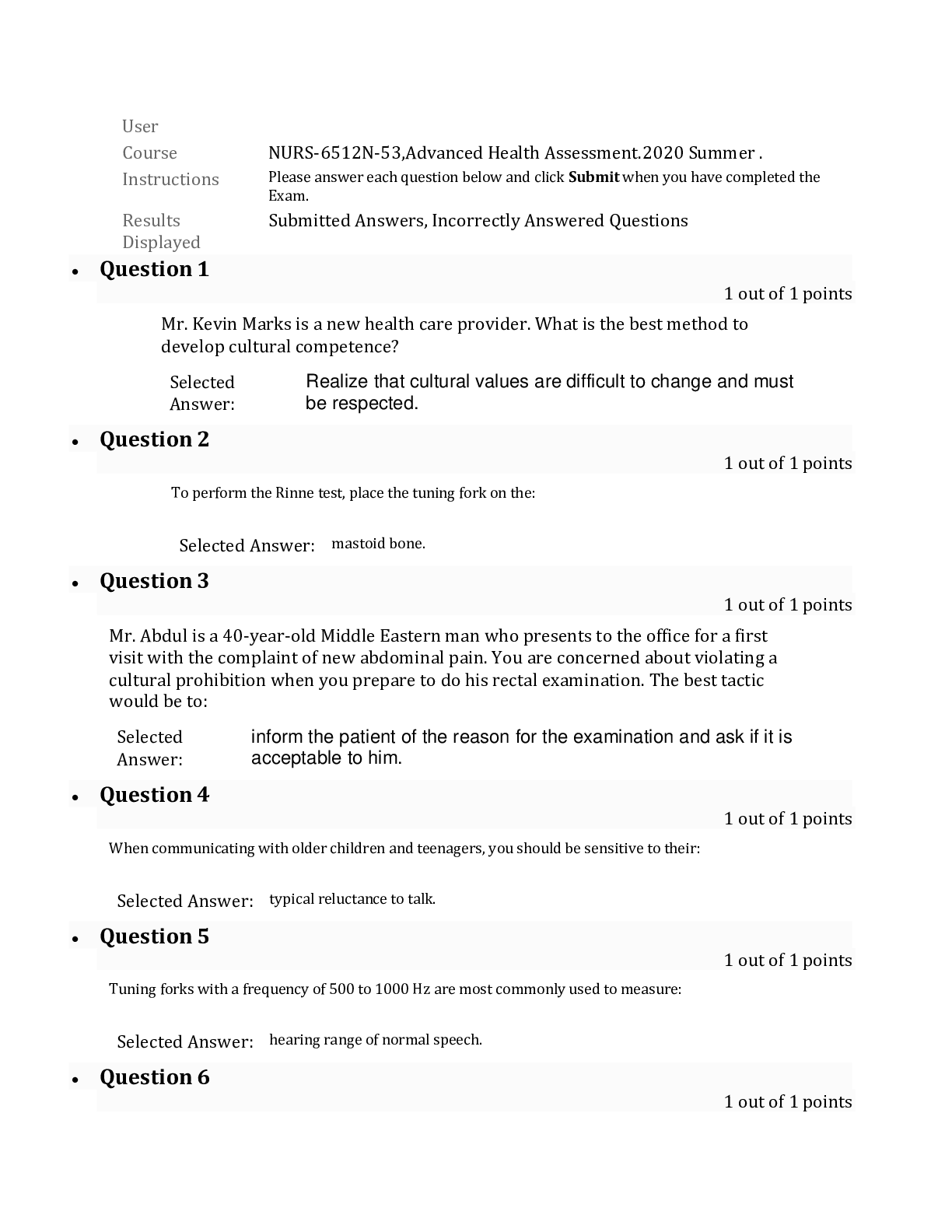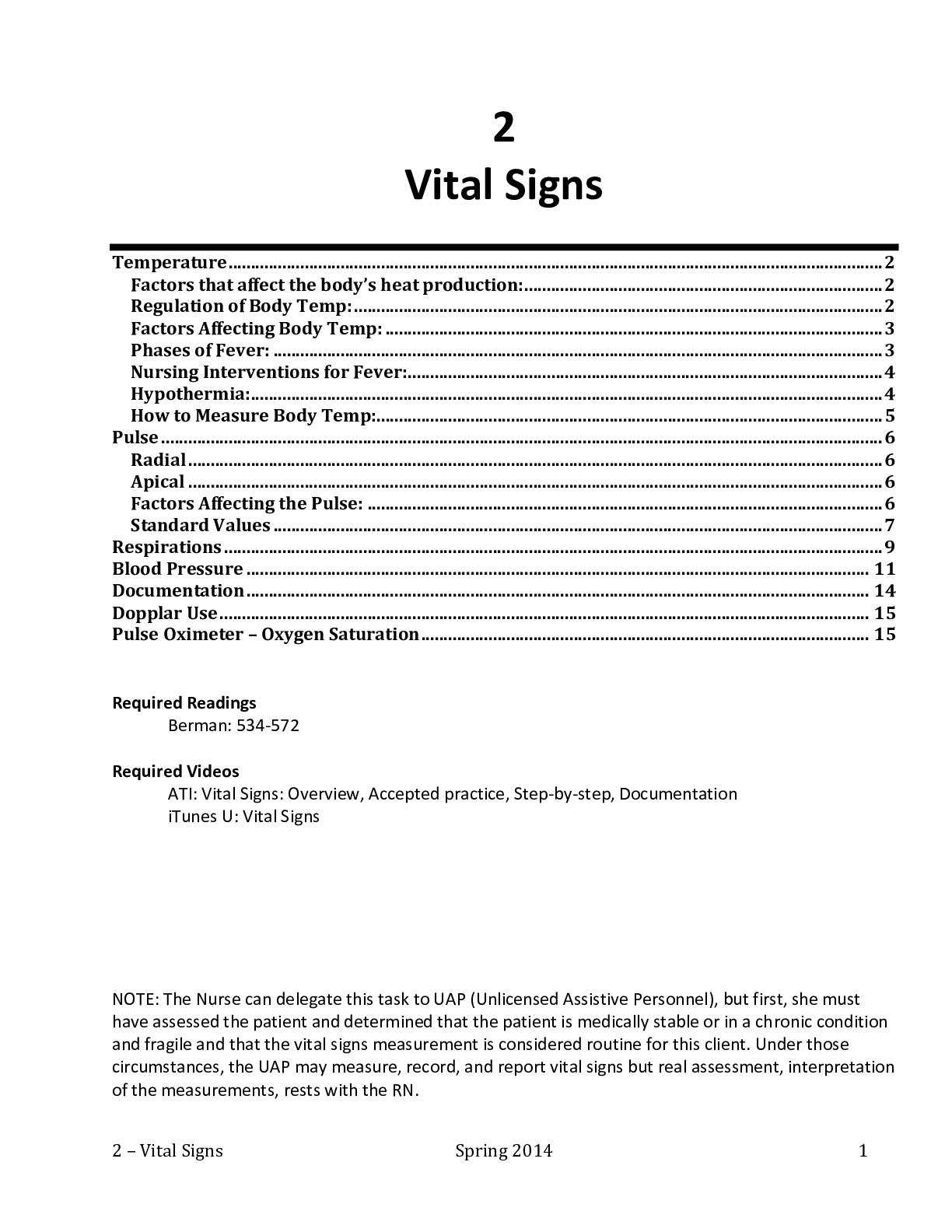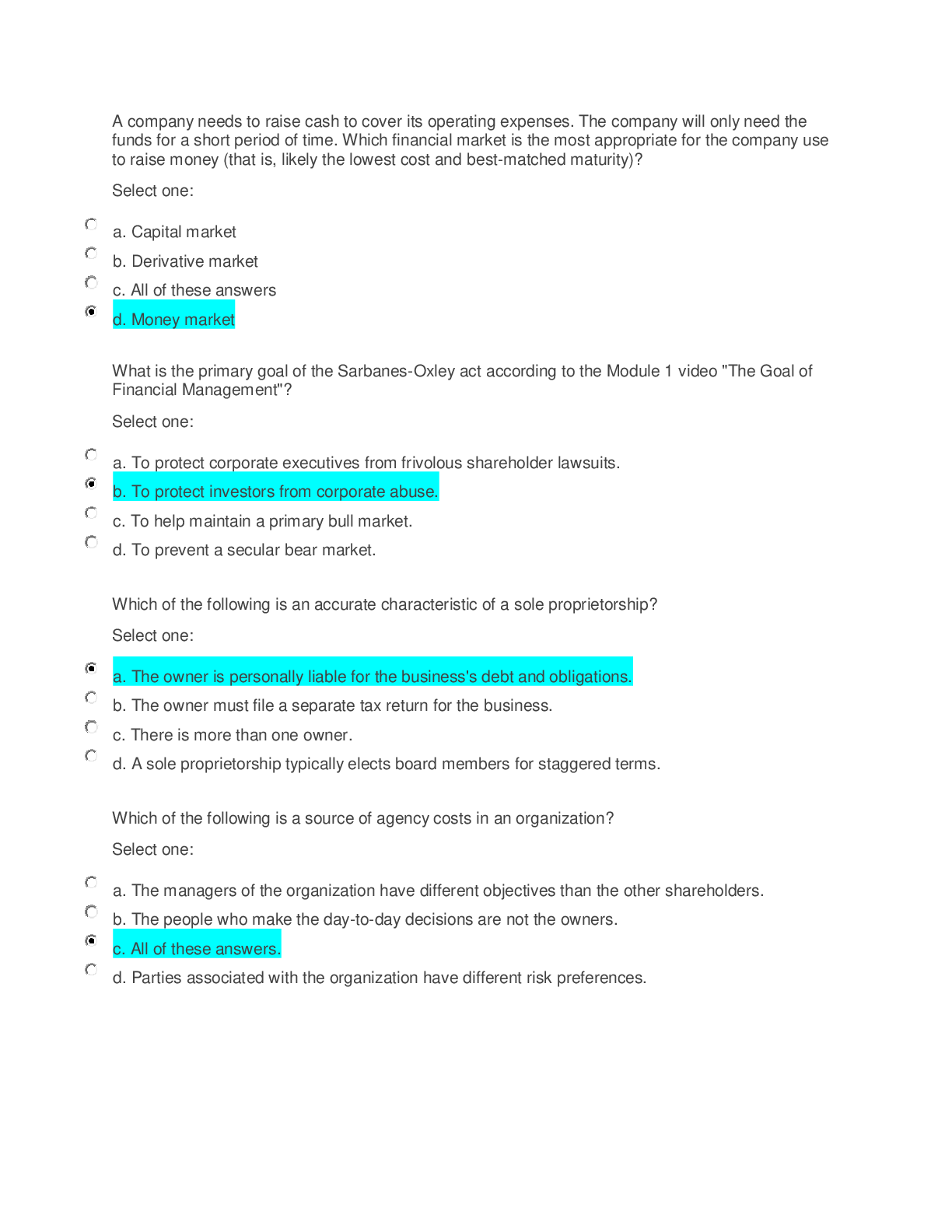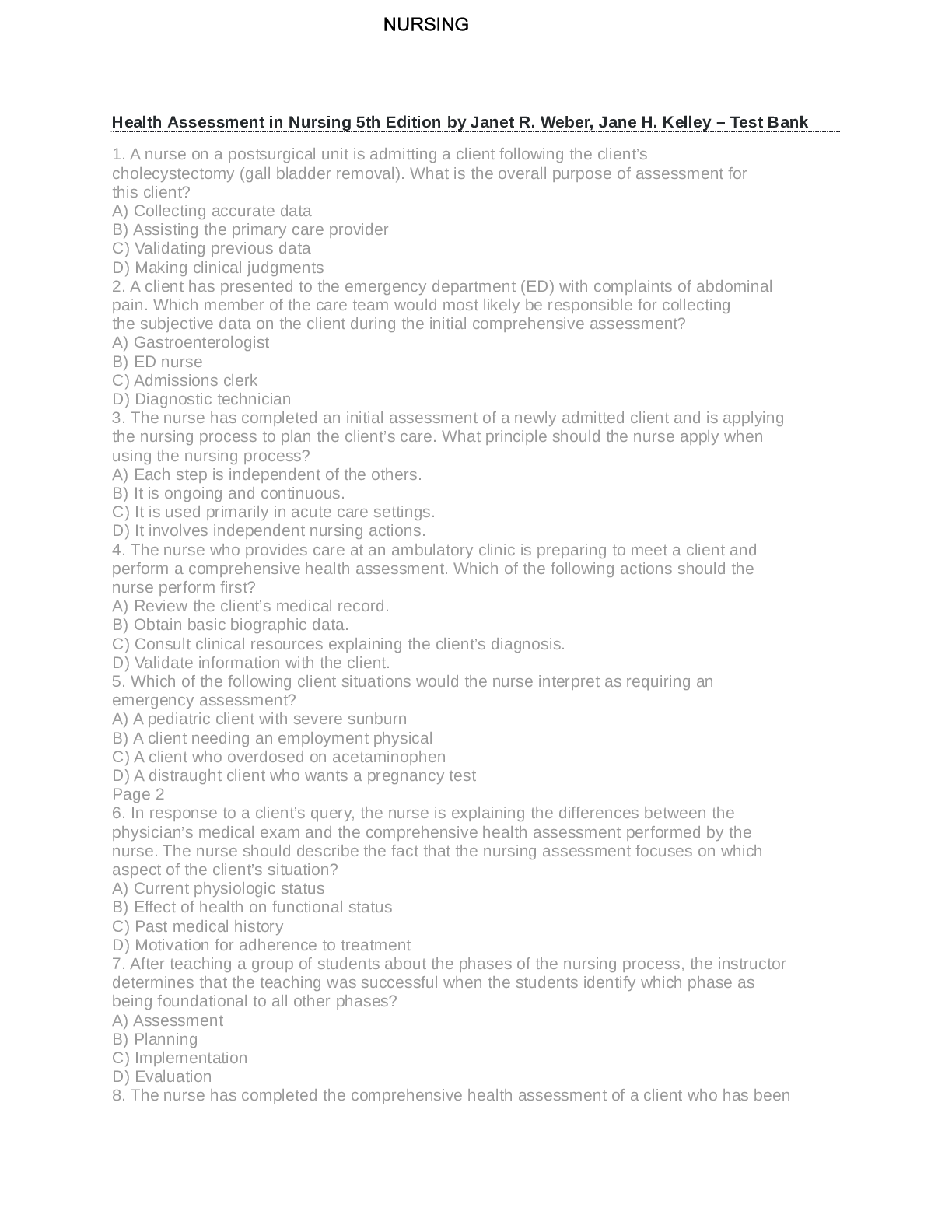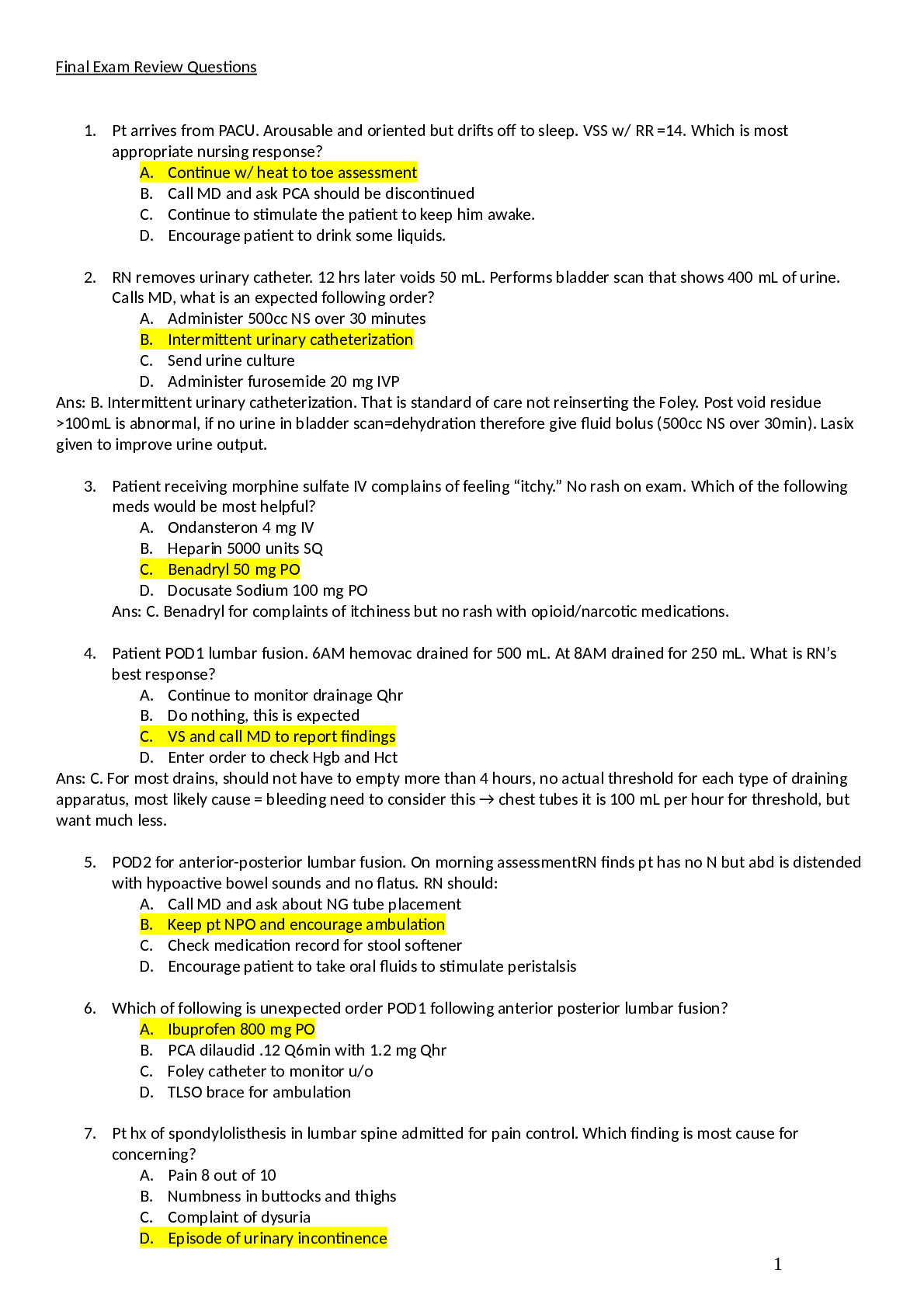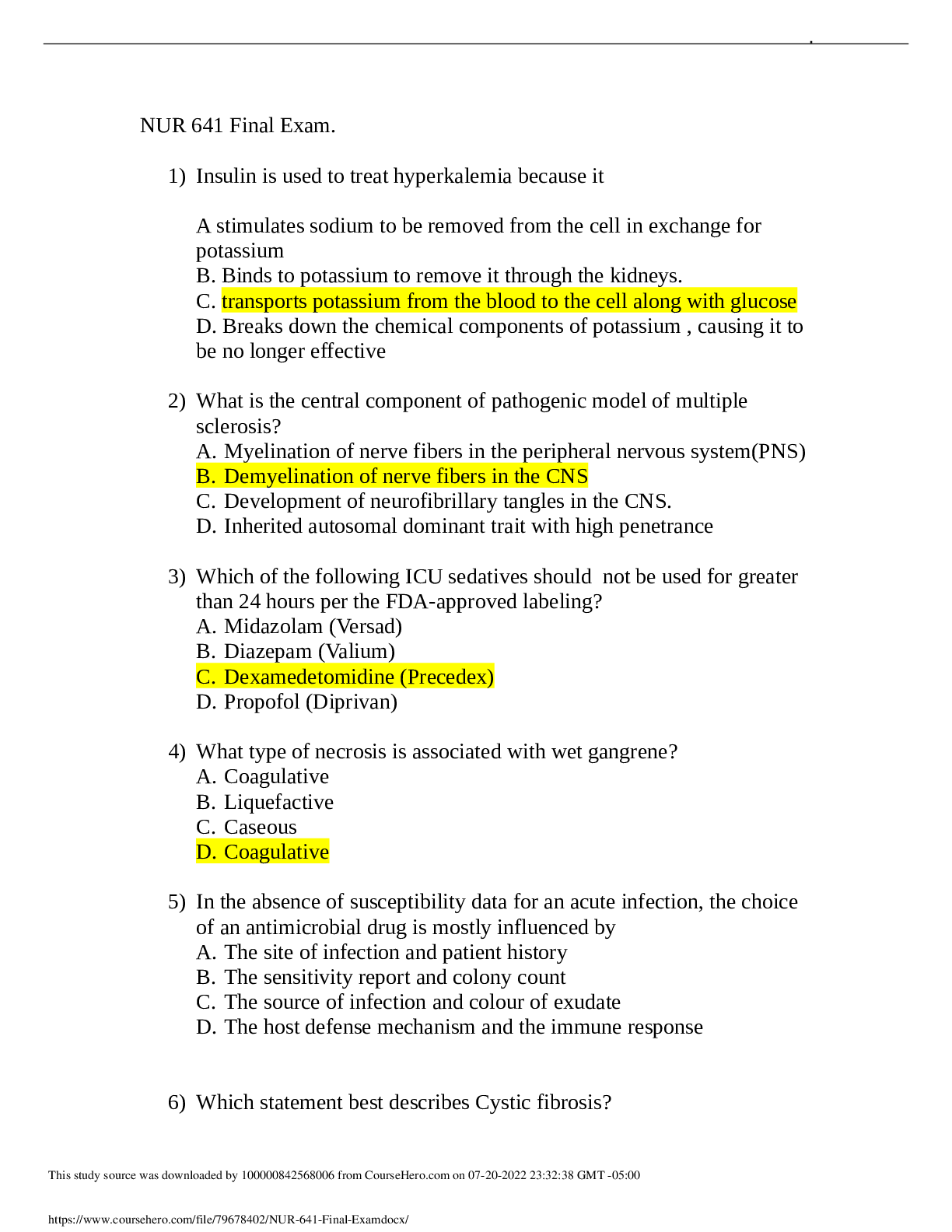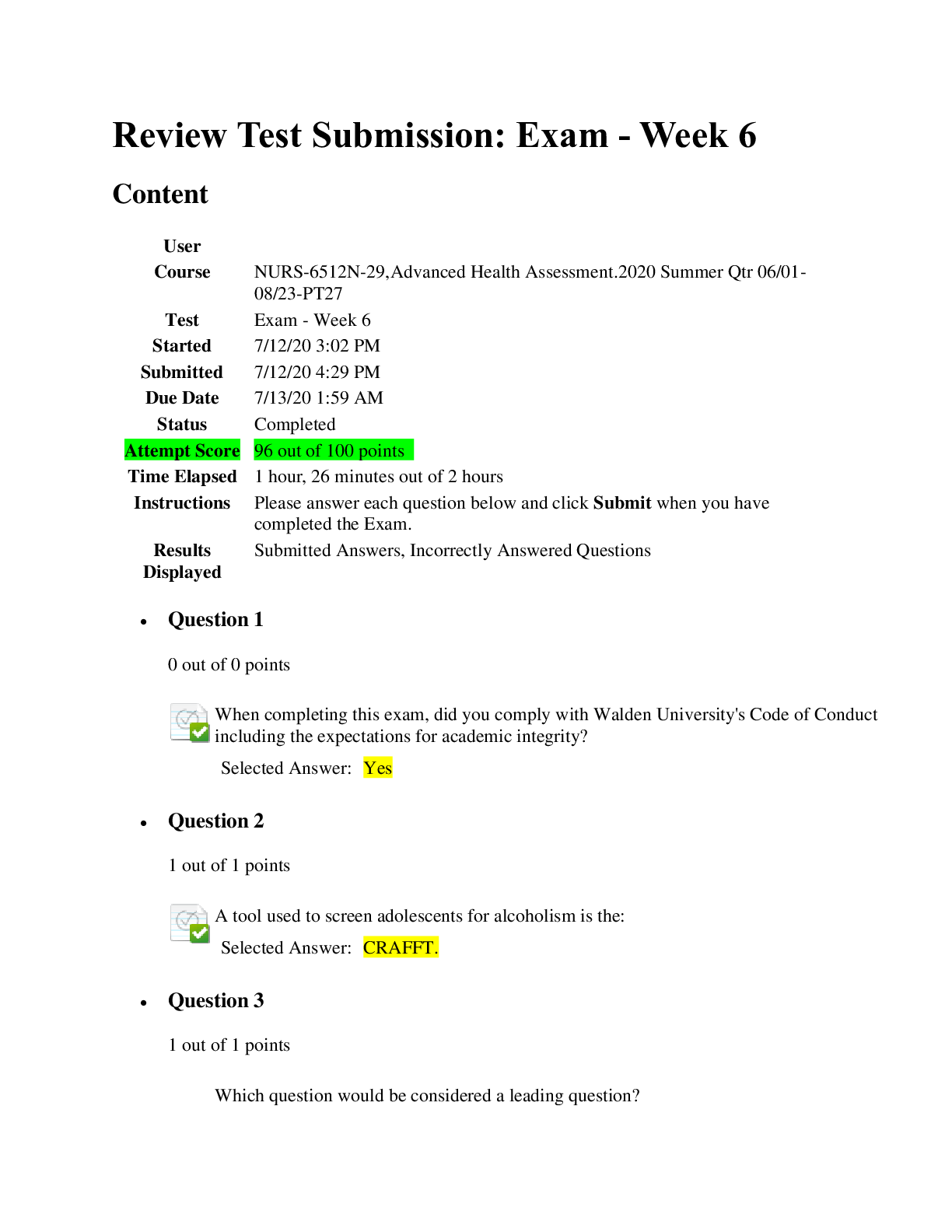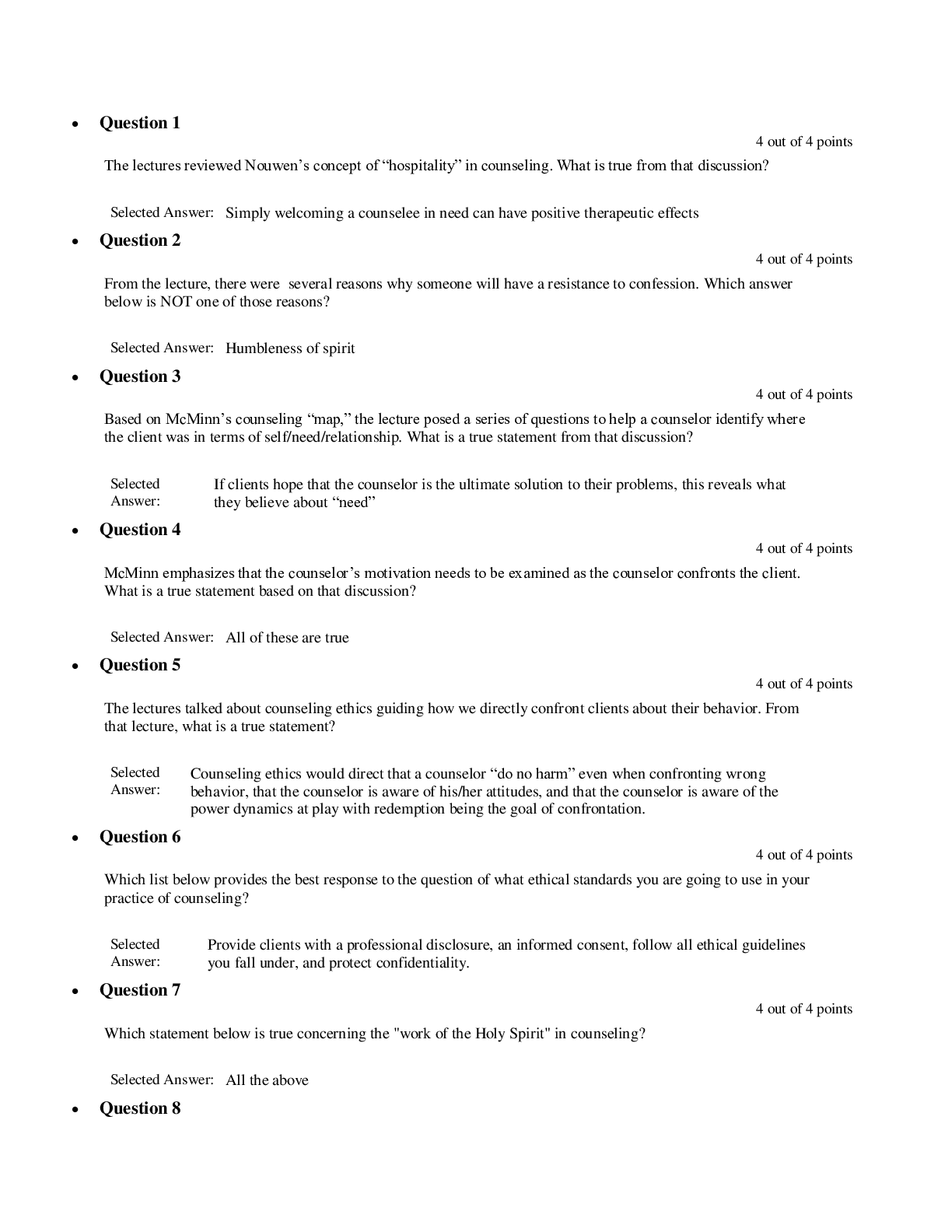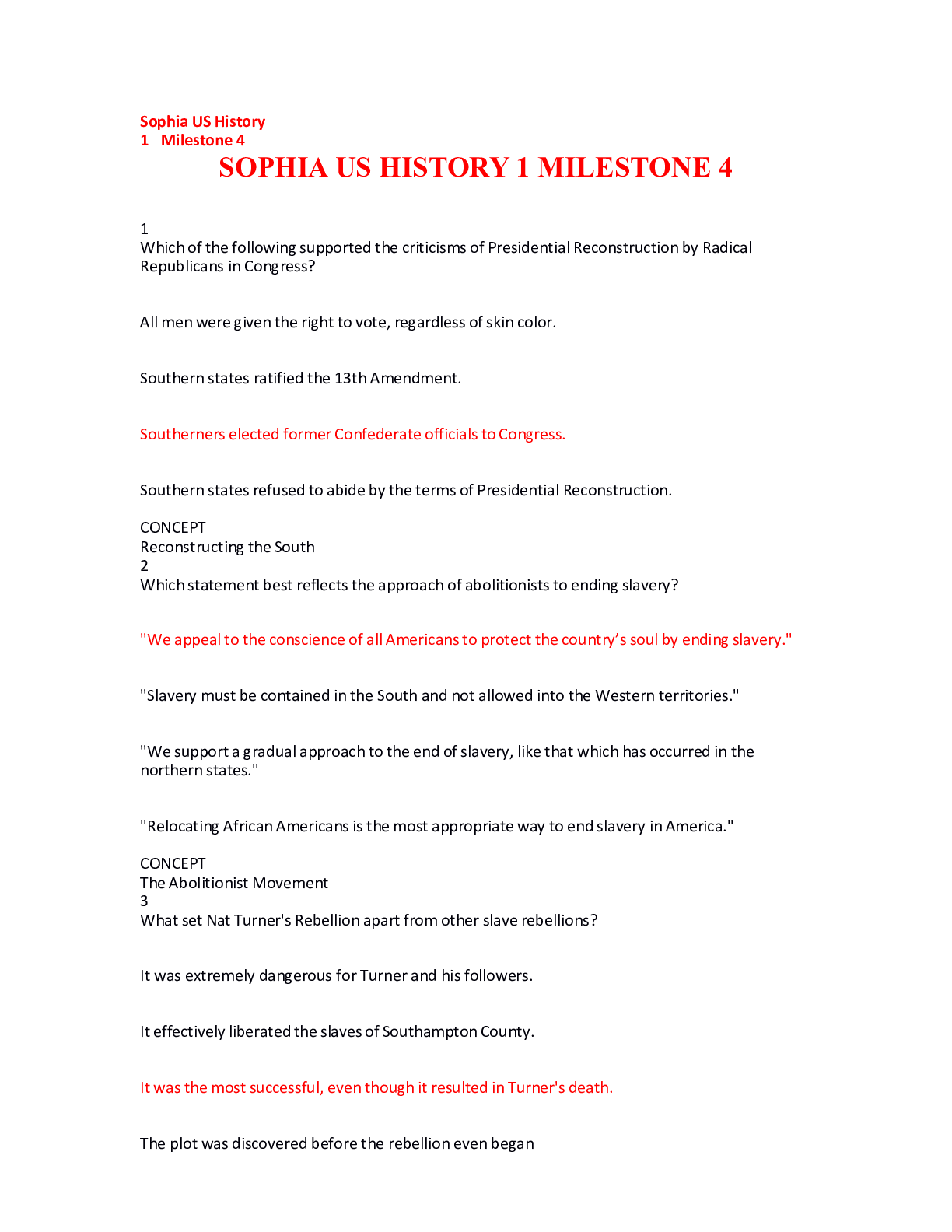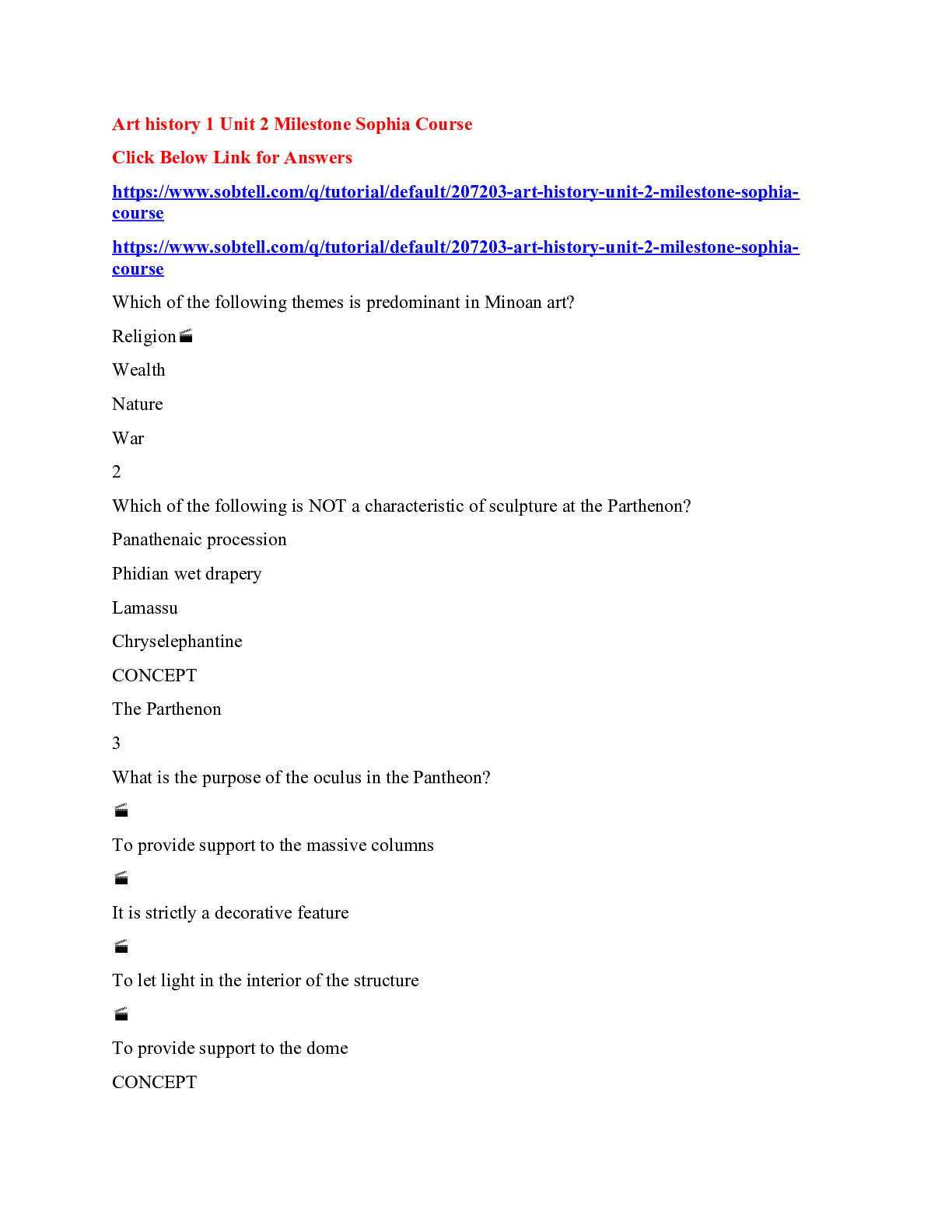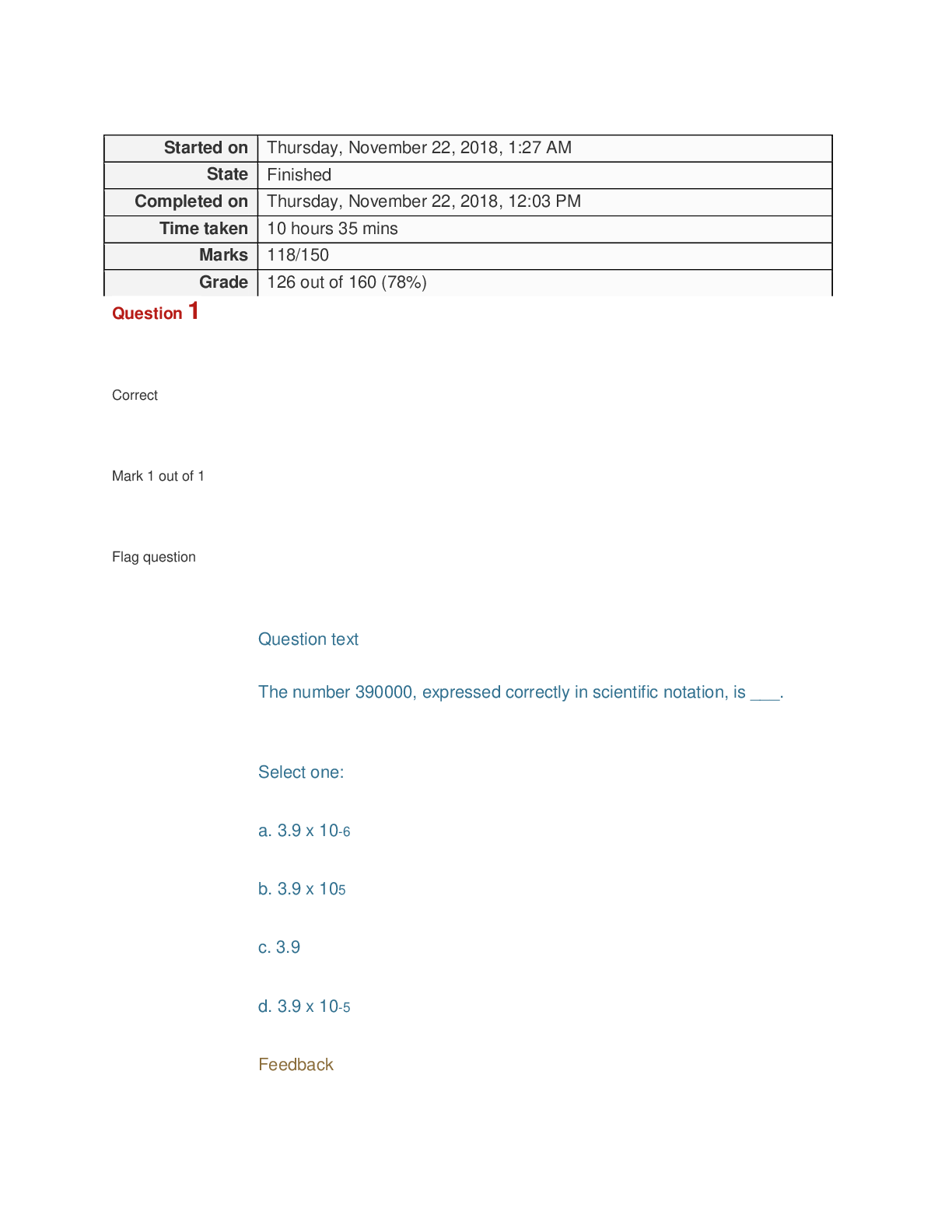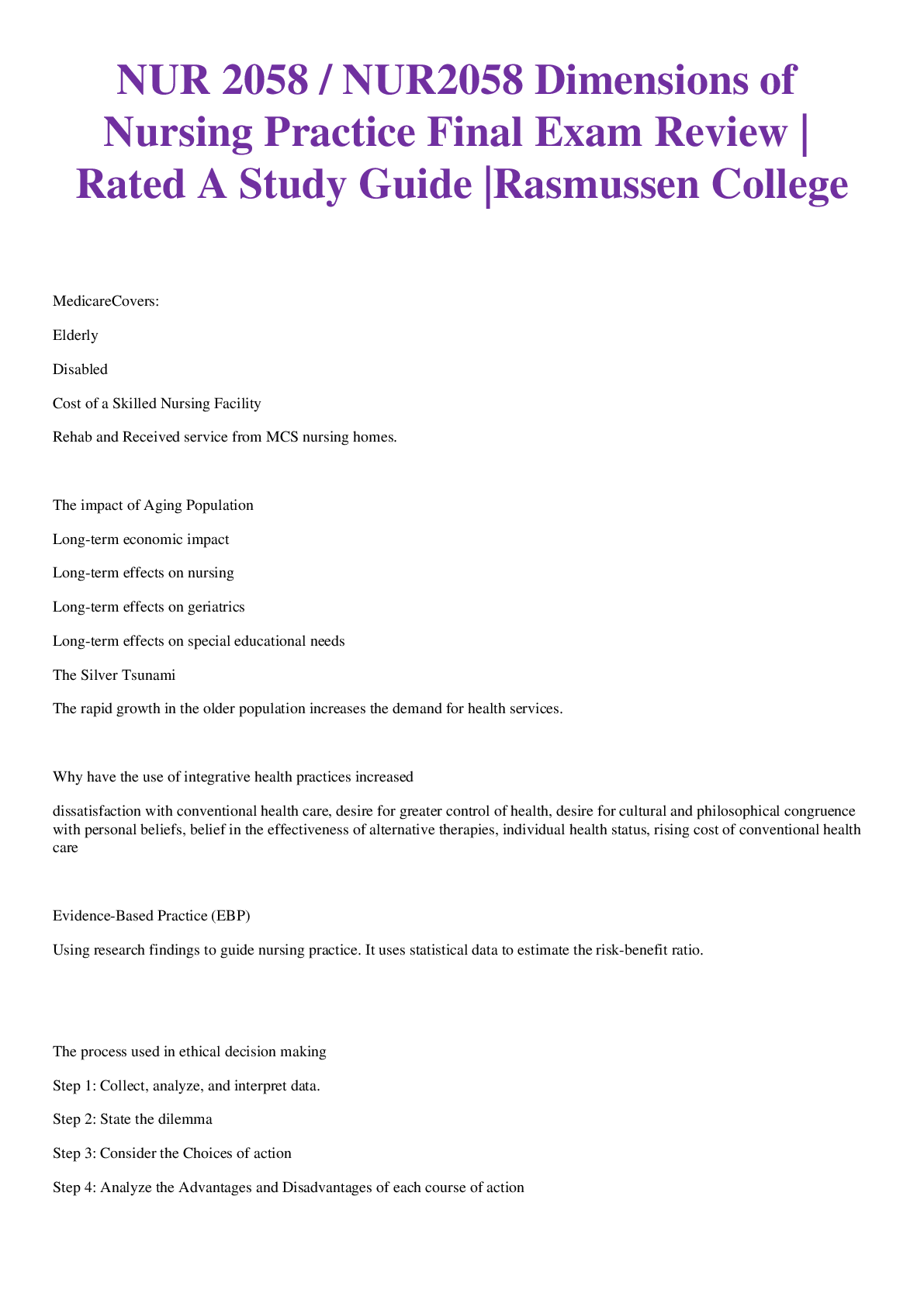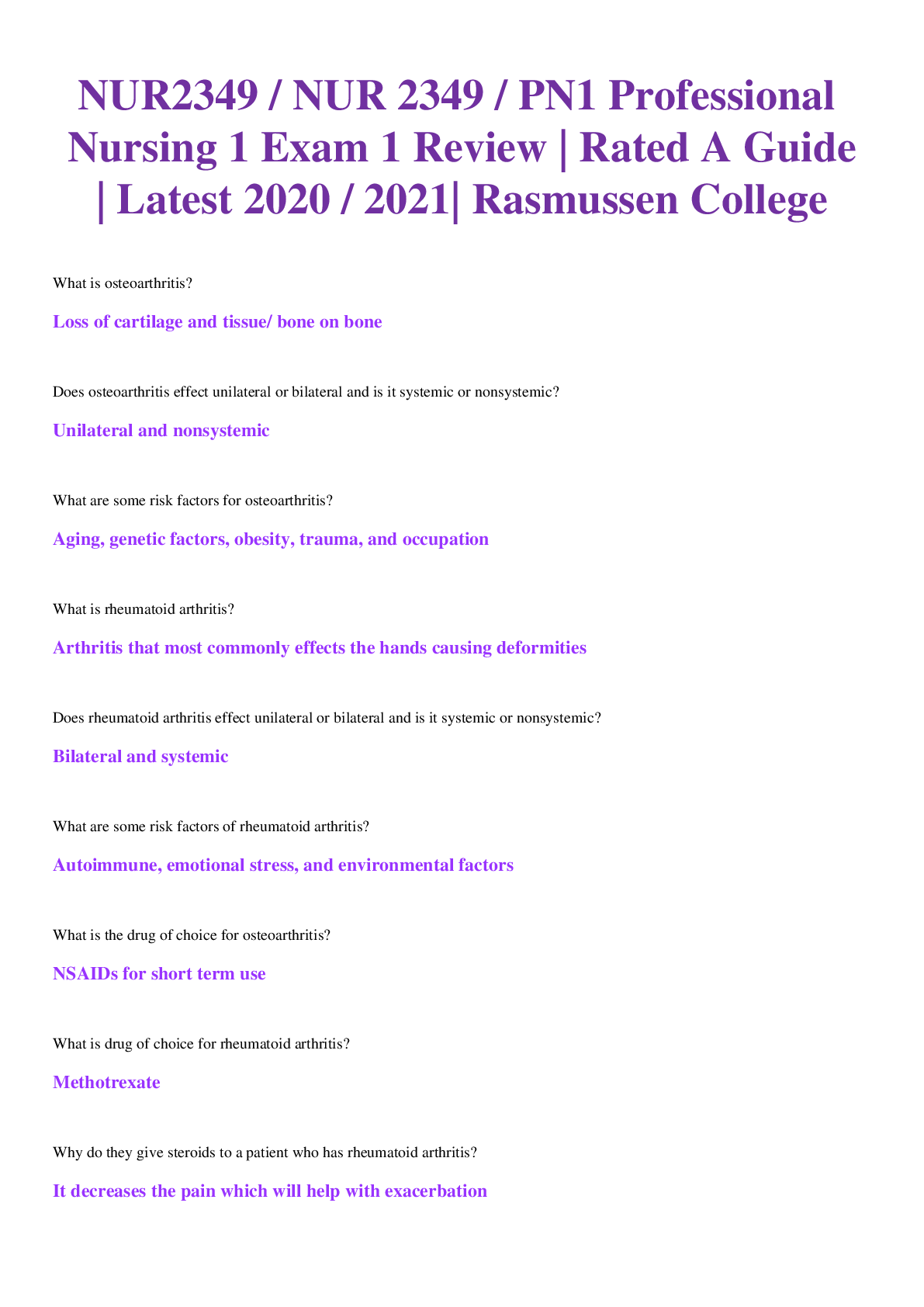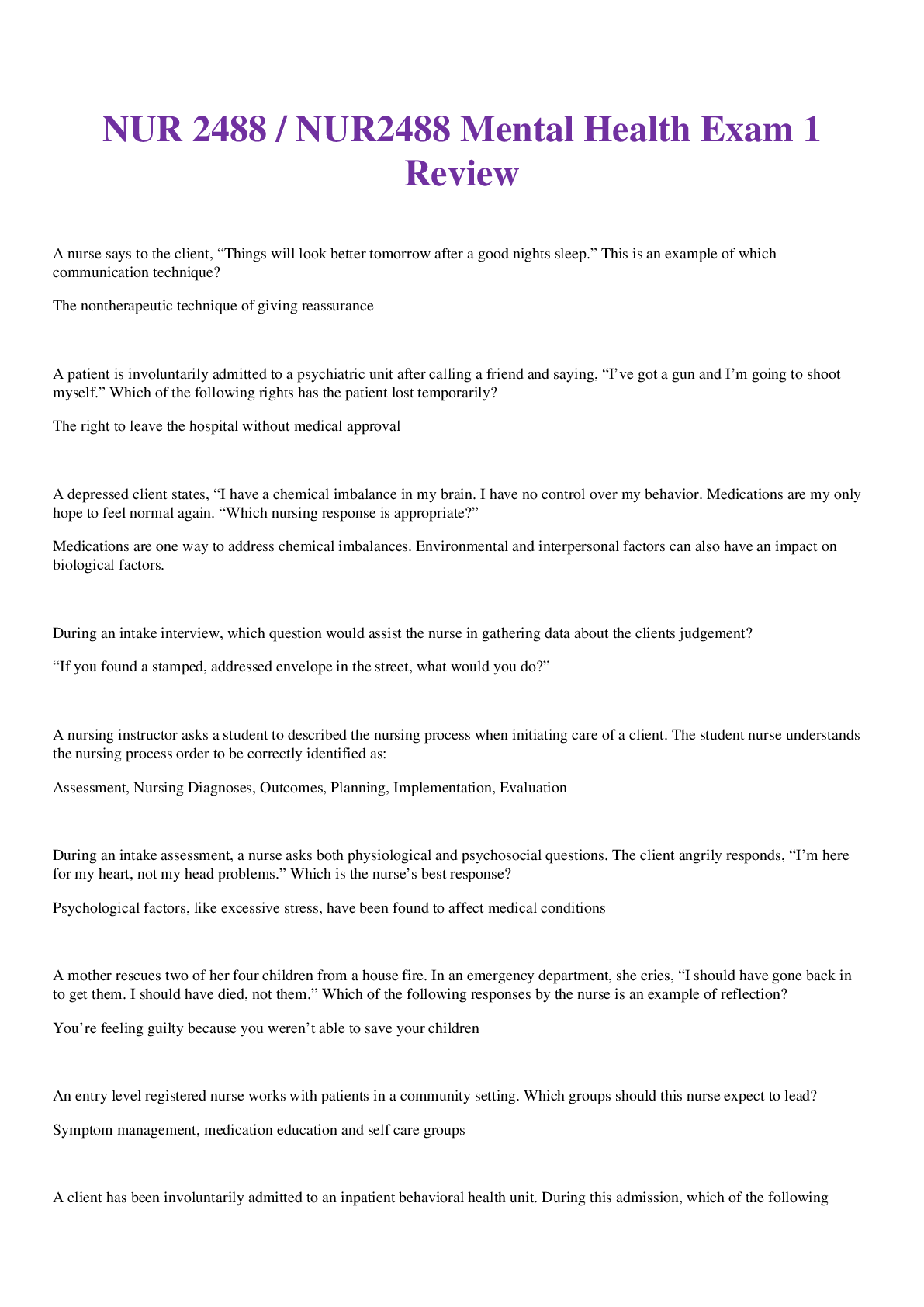History > EXAM REVIEW > Sophia Art History 1 Milestone 2 (Solutions)|Art history 1 Unit 2 Milestone Sophia Course (All)
Sophia Art History 1 Milestone 2 (Solutions)|Art history 1 Unit 2 Milestone Sophia Course
Document Content and Description Below
Which of the following best describes this sculpture? • Subject portrays age and wisdom • Subject is depicted in the Flavian style • Subject's physical imperfections are emphasized ... • Subject is portrayed as a god CONCEPT Portraiture, Republic to Flavians 2 Select the option that correctly explains the function of the vase shown above. • All-purpose vessel used to store liquids • Vessel used for drinking wine • Vessel used to mark a gravesite • Vessel used to commemorate victory CONCEPT Vase Painting 3 Which architectural element is common amongst both Greek and Etruscan architecture? • Use of concrete • Rounded arches • Labyrinths • Atriums CONCEPT The Romans and the Etruscans 4 Which of the following correctly describes this image? • Contrapposto • Calf Bearer • Kore • Peplos CONCEPT The Human Figure in Greek Sculpture 5 Which of the following is NOT an architectural feature of the Great Stupa at Sanchi? • Harmika • Toranas • Yasti • Circumambulation CONCEPT The Great Stupa at Sanchi 6 Which of the following characteristics is commonly found in Neolithic architectural sites? • Ziggurat • Hypostyle hall • Masonry • Clerestory CONCEPT Early Architecture 7 The temple of Amun-Mut-Khonsu is a classic example of a(n) __________, because of its use of huge entry gate. • mastaba • colonnade • pylon temple • necropolis CONCEPT New Kingdom Architecture 8 Which of the following is the name of the oldest and most authoritative Hindu religious texts? • Sarnath • Trefoil • Ashoka • Vedas CONCEPT Ancient India 9 Which of the answer choices lists a characteristic that is NOT present in the Arch of Constantine? • Relief sculpture • Spolia • Basilica • Triumphal arch CONCEPT Monuments, the Later Empire, Constantine 10 The development of stone tools, cave paintings, and sculpted figures characterize the __________ era of prehistory. • Paleolithic • Archeaological • Egyptian • Neolithic CONCEPT Prehistory 11 The simplest and oldest order used in Greek temples was the __________ order. • Peripteral • Corinthian • Entasis • Doric CONCEPT Greek Temples 12 Compare and contrast the Parthenon to the Pont du Gard. Select the option that is reflective of the Pont du Gard. • Doric order • Post and lintel — can only span a short space • Made of concrete fill with stone veneer • Built to gain popular approval CONCEPT Recognizing Elements of Roman Architecture in Greek Temples 13 Which of the following is the correct definition of "controlled space?" • A type of civic design that is intended to impress or intimidate viewers • A Sumerian temple in the form of a pyramid tower with round, winding stories • A Sumerian deity with a bull or lion's body, an eagle's wings, and a human head • An agricultural region in the Middle and Near East CONCEPT Ancient Near East 14 Select the statement that is FALSE about Yakshi figures. • The Yakshi figures date from the same period as the Great Stupa at Sanchi. • These figures are spirits associated with fertility and protection. • Yakshi are female earth spirits that have ties to Buddhism, Hinduism, and Jainism. • They are often depicted as petite and dainty female figures. CONCEPT Yakshi Figures 15 What keeps the massive dome of the Pantheon from collapsing? • The use of interior iron supports. • The use of concrete and coffers. • The use of wood instead of concrete or stone. • The use of flying buttresses on the exterior. CONCEPT The Pantheon 16 Which sculptor carved the distinctive wet drapery on the human figures in the Parthenon? • Athena • Lyssipus • Polykleitos • Phidias CONCEPT The Parthenon 17 Select the statement that is TRUE about Chaitya Hall. • It blends both Indian and Greek styles. • It is the oldest Buddhist shrine. • It is a center for monastic worship. • It is carved out of thousands of pieces of stone. CONCEPT Ancient Indian Art until 300 AD 18 Which of the following correctly identifies the civilization associated with this work of art? • Aegean (Cycladic) • Ancient Egyptian • Mycenaean • Minoan CONCEPT Aegean Art 19 Which of the following does NOT correctly describe a Roman atrium? • Often planted with fruit trees • Place for rituals associated with familial cults • Serious and formal space • Center of domestic life CONCEPT The Roman House 20 Which of the following works of art is from the Amarna Period? 1 2 3 4 CONCEPT Amarna Period and Afterward 21 Which of the following correctly identify a Greek deity and his or her primary association? • Hephaestus - god of peace • Aphrodite - goddess of war • Nike - goddess of love • Poseidon - god of the sea CONCEPT Ancient Greece 22 Which of the following characteristics are present in this image from Chauvet Cave? • Abstraction, descriptive point of view • Descriptive point of view, votive figure • Megalithic, abstraction • Votive figure, megalithic CONCEPT Cave Painting 23 Which of the following are characteristics of Etruscan art and/or architecture? • Archaic smile, domus • Domus, atrium • Ridgepole, Archaic smile • Atrium, ridgepole CONCEPT The Etruscans 24 Which of the following terms best describes the ancient funerary complex at Saqqara, Egypt? • Hieratic scale • Colonnade • Necropolis • Pylon temple CONCEPT Old Kingdom Architecture 25 Which of the following characteristics are included in this statue of Khafre? • Canon of proportions, register • Register, hieratic scale • Hieratic scale, ka • Ka, canon of proportions CONCEPT Ancient Egypt 26 Which of the following characteristics can be used to identify Sumerian votive figures? • Heroic warriors, solar disks • Clasped hands, heroic warriors • Solar disks, wide-eyed • Wide-eyed, clasped hands CONCEPT Sumer 27 Select the trait of Mycenaean architecture that is represented in this image. • Beehive tombs • Corbeled vault • Votive figures • Cyclopean construction CONCEPT Mycenaean Art 28 Which of the following sculptures is from the Hellenistic period? 1 2 3 4 CONCEPT Late Classical and Hellenistic Periods 29 Which of the following rulers is known for promoting Buddhism, and for commissioning the construction of pillars inscribed with his laws, during the Mauryan period? • Ashoka • Hammurabi • Naram-Sin • Ashurnasirpal II CONCEPT Influence of Buddhism on Ancient Indian Art 30 Which of the following themes is NOT a predominant theme of Minoan art? • Religion • Liveliness • Nature • Energy CONCEPT Minoan Art 31 Think about the early forms of religion in India and how they differ. Where did the Buddhist Sangha first come into existence through the enlightenment of Kondanna? • Ashoka • Dharma • Sarnath • Vedas CONCEPT Differentiating Early Forms of Religion in India 32 Which of the following describes the function of the Dying Lioness relief sculpture from the North Palace of Ashurbanipal? • To commemorate the king's victories in battle • To demonstrate the king's power over nature • To protect and intimidate through size • To depict a story from mythology CONCEPT Art as Expression of Authority: Akkad and Assyria 33 Which of the following does NOT correctly describe the type of architecture represented in the image? • Amphitheater • Oculus • Aqueduct • Pseudoperipteral temple CONCEPT Elements of Roman Architecture © 2020 SOPHIA Learning, LLC. SOPHIA is a registered trademark of SOPHIA Learning, LLC. [Show More]
Last updated: 1 year ago
Preview 1 out of 14 pages
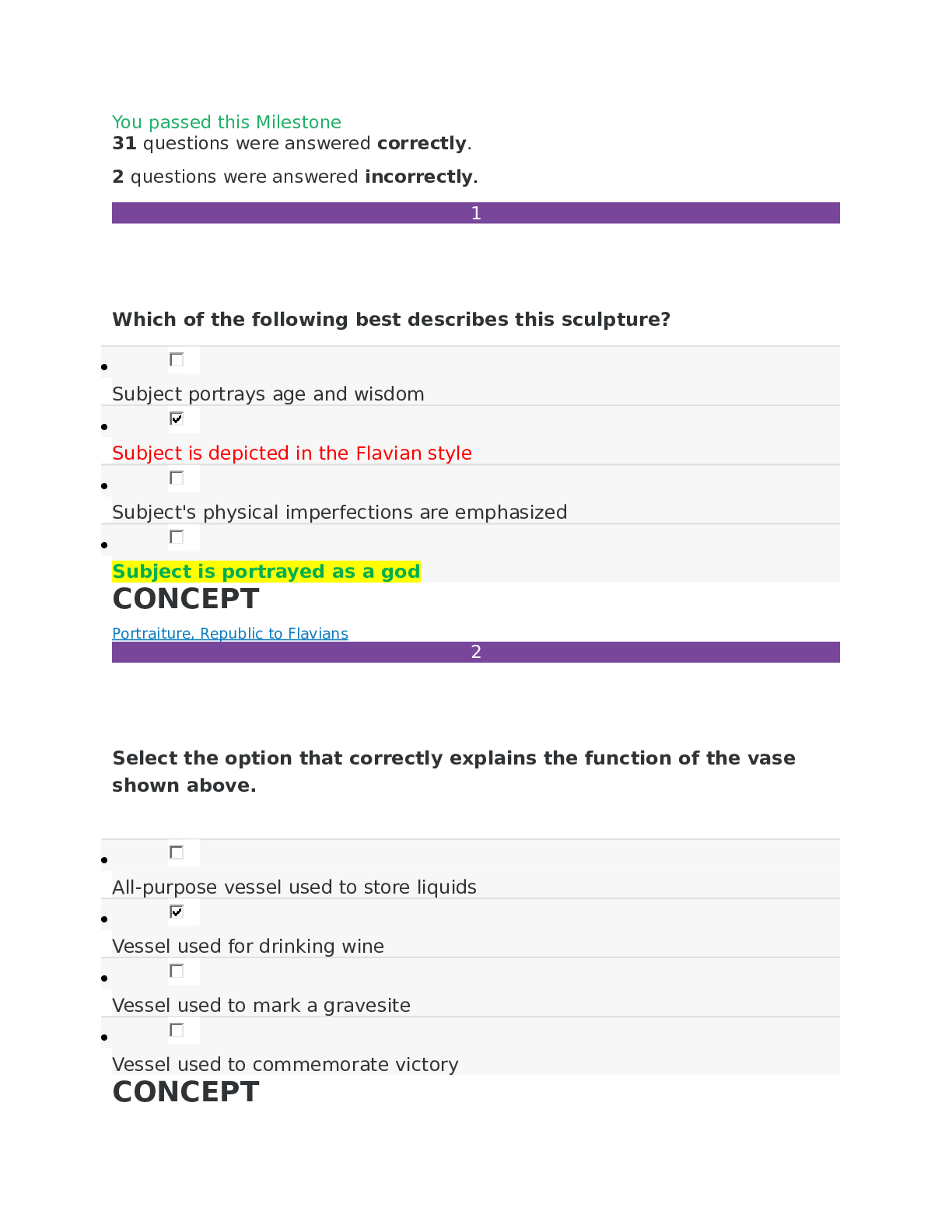
Reviews( 0 )
Document information
Connected school, study & course
About the document
Uploaded On
Jan 31, 2021
Number of pages
14
Written in
Additional information
This document has been written for:
Uploaded
Jan 31, 2021
Downloads
0
Views
224



